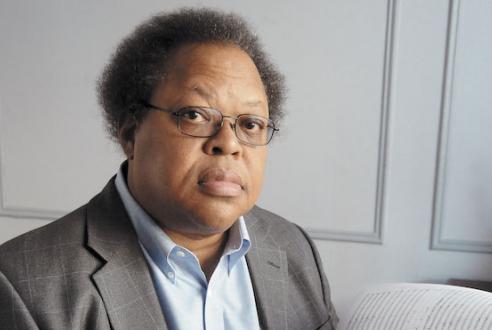Columbia Professor, legendary trombonist, improvisor and scholar George Lewis speaks a bit about his new work for Talea and about his compositional approach.
Talea will be premiering your work, Mnemosis, on December 14th. What was the point of departure for this piece?
Mnemosis draws inspiration from two conceptions of time, history and memory in Western philosophy: Nietzsche’s notion of the eternal recurrence, and Wittgenstein’s conception of Unzeitlichkeit, which is to my mind inadequately translated as “timelessness,” although I don’t have an alternative handy.
Throughout Mnemosis there are measures / blocks of material that are strictly repeated two or sometimes three times and this activity stops at the end where the ensemble finally plays rhythmically together. This plays into the title of the piece. Can you speak more about this?
Over the past few years I’ve used repeated passages to create moments of stasis and reflection, most notably in my 2011 composition for large ensemble, The Will To Adorn. In that work the repetition sections are more cryptic, but Mnemosis is perhaps my first piece that is rather extensively based on repetition, using a process that might recall in some ways the concept of suspension in fourth-species counterpoint. Rather than notes, the units of suspension are “blocks” or modules of behavior in a given instrument or grouping of instruments that recur at irregularly displaced time points relative to other groupings. The procedure also recalls the “visualization” paintings of Jack Ox (see http://abstractcomics.blogspot.com/2009/07/kurt-schwitters-ursonate-by-jack-ox.html and http://www.jackox.net/pages/bruckner/BrucknerText.html), in which a single architectural image is divided into equally-spaced strips and becomes fractured by vertical displacement of individual strips. In Mnemosis, the “strips” may be conceived as temporally displaced in a conceptually horizontal way. As with the Ox paintings, a sense of progress and stasis gradual develops upon sustained engagement. However, this is not “music as a gradual process”; although moments of local recursion are frequent, so are sudden changes of perspective and flow.
What are some of the criteria that you have for yourself to evaluate your own work’s successes or failures, if you even use those terms of critique?
Since I’m basically an experimental composer, the goalposts for success are constantly moving, but the question reminds me of that wonderful article about Michael Tilson Thomas visiting Carl Ruggles. At the time Ruggles was 95 years old and basically on his deathbed in a nursing home. Thomas puts headphones on Ruggles’s head and plays Sun-Treader (which I admit to having a long love affair with) and Ruggles starts singing along, yelling “Great! DAMN FINE WORK!” If I’m enjoying listening to a piece of mine like that, and if I feel that I’ve gone as far as I could go for that moment in terms of the organization and the construction of sound, I suppose that it’s successful for me.
How do you approach composition?
Well, as the fellow in the Quentin Tarantino movie Pulp Fiction put it, I’m in a transitional period at the moment, and there have been distinct changes in the way I approach composing. First of all, these days I try to concentrate on making each moment of sound physically and emotionally evocative. This operates in tandem with my second principle, which is to avoid the unadorned moment. I like to keep the inner life of sounds moving, rather like the “aural exciters” in early studio electronics that were designed to introduce microfluctuations with the goal of avoiding psychological habituation. Moments of repose are outnumbered by overstuffed nonlinearity, and I like to manage noisy, unstable textures that “decorate the decorations,” as Zora Neale Hurston put it.
How do you conceive of form and pitch material?
Lately I’ve enjoyed deriving pitch material the old-fashioned way–that is, old-fashioned circa 1980s, using analyses of musical instrument spectra. For example, Mnemosis and other works use spectra drawn from my audio library of bassoon and saxophone multiphonics. In planning the works, I create modular moments that work for me, and decide later how they are to flow as a sequence; modules that don’t fit the emerging conception of the flow of the work are saved for another time, and sometimes, modules become superimposed upon each other. In performance, the pieces operate in perceptually concatenationist mode; listeners catch the bus and go along for the ride, and I try to avoid teleologies, motivic elaboration, and global form. In this, again, I’m guided by the Wittgenstein quote from proposition 6.4311 of the Tractatus Logico-Philosophicus: “If by eternity is understood not endless temporal duration but timelessness, then he lives eternally who lives in the present.” Living in the present with Talea has been an excellent place to be; I very much look forward to this concert and would like to thank them for their support for my work and that of so many others.
Finally, if the concert is about remembrance, I’d like to have us remember Jonathan Harvey, who just left us.
SYNCHRONICITIES: NEW WORKS
PREMIERES BY LEWIS, TRAPANI, LEHMAN, CHEUNG
DECEMBER 14, 2012 8:00 PM
MANNES COLLEGE OF MUSIC
150 W 85TH STREET
NEW YORK, NY 10024
*FREE ADMISSION

